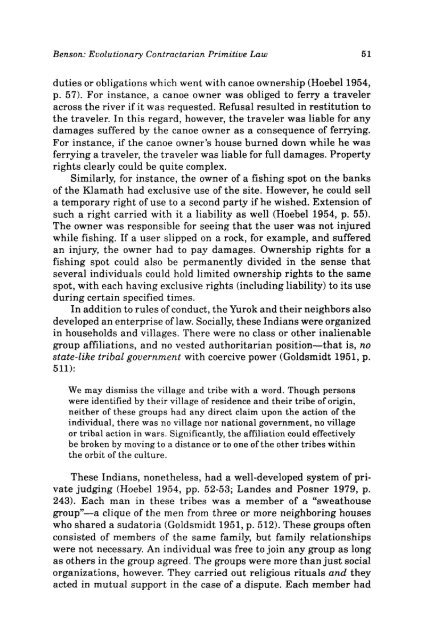Review of Austrian Economics - The Ludwig von Mises Institute
Review of Austrian Economics - The Ludwig von Mises Institute
Review of Austrian Economics - The Ludwig von Mises Institute
You also want an ePaper? Increase the reach of your titles
YUMPU automatically turns print PDFs into web optimized ePapers that Google loves.
Benson: Evolutionary Contractarian Primitive Law 51<br />
duties or obligations which went with canoe ownership (Hoebel 1954,<br />
p. 57). For instance, a canoe owner was obliged to ferry a traveler<br />
across the river if it was requested. Refusal resulted in restitution to<br />
the traveler. In this regard, however, the traveler was liable for any<br />
damages suffered by the canoe owner as a consequence <strong>of</strong> ferrying.<br />
For instance, if the canoe owner's house burned down while he was<br />
ferrying a traveler, the traveler was liable for full damages. Property<br />
rights clearly could be quite complex.<br />
Similarly, for instance, the owner <strong>of</strong> a fishing spot on the banks<br />
<strong>of</strong> the Klamath had exclusive use <strong>of</strong> the site. However, he could sell<br />
a temporary right <strong>of</strong> use to a second party if he wished. Extension <strong>of</strong><br />
such a right carried with it a liability as well (Hoebel 1954, p. 55).<br />
<strong>The</strong> owner was responsible for seeing that the user was not injured<br />
while fishing. If a user slipped on a rock, for example, and suffered<br />
an injury, the owner had to pay damages. Ownership rights for a<br />
fishing spot could also be permanently divided in the sense that<br />
several individuals could hold limited ownership rights to the same<br />
spot, with each having exclusive rights (including liability) to its use<br />
during certain specified times.<br />
In addition to rules <strong>of</strong> conduct, the Yurok and their neighbors also<br />
developed an enterprise <strong>of</strong> law. Socially, these Indians were organized<br />
in households and villages. <strong>The</strong>re were no class or other inalienable<br />
group affiliations, and no vested authoritarian position—that is, no<br />
state-like tribal government with coercive power (Goldsmidt 1951, p.<br />
511):<br />
We may dismiss the village and tribe with a word. Though persons<br />
were identified by their village <strong>of</strong> residence and their tribe <strong>of</strong> origin,<br />
neither <strong>of</strong> these groups had any direct claim upon the action <strong>of</strong> the<br />
individual, there was no village nor national government, no village<br />
or tribal action in wars. Significantly, the affiliation could effectively<br />
be broken by moving to a distance or to one <strong>of</strong> the other tribes within<br />
the orbit <strong>of</strong> the culture.<br />
<strong>The</strong>se Indians, nonetheless, had a well-developed system <strong>of</strong> private<br />
judging (Hoebel 1954, pp. 52-53; Landes and Posner 1979, p.<br />
243). Each man in these tribes was a member <strong>of</strong> a "sweathouse<br />
group"—a clique <strong>of</strong> the men from three or more neighboring houses<br />
who shared a sudatoria (Goldsmidt 1951, p. 512). <strong>The</strong>se groups <strong>of</strong>ten<br />
consisted <strong>of</strong> members <strong>of</strong> the same family, but family relationships<br />
were not necessary. An individual was free to join any group as long<br />
as others in the group agreed. <strong>The</strong> groups were more than just social<br />
organizations, however. <strong>The</strong>y carried out religious rituals and they<br />
acted in mutual support in the case <strong>of</strong> a dispute. Each member had

















